| Volume
75
Caleta Candelero Chico and Bahia Candelero
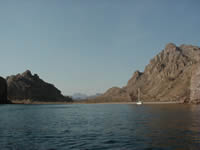 Our
course from Isla Monserrat to Caleta Candelero Chico (Little Candelero
Cove) looked to be leading us straight into a steep cliff side.
At the last moment a huge boulder opened up on our left revealing
a 65’ wide passage into a compact one-boat anchorage. Wouldn’t
you know, there was already one boat there! And a power boat, to
boot. Upon closer inspection, however, the powerboat turned out
to be our German friends aboard Isla Bonita (the couple we’d
last seen rolling their guts out with us in Estero Ballandra), so
we proceeded in and poked around to see if a second boat could be
squeezed in. We were just about to give up, when they emerged from
their nap to tell us they would be leaving in a few hours. So we
dropped the hook and visited a bit, and then waved goodbye as they
departed. Our
course from Isla Monserrat to Caleta Candelero Chico (Little Candelero
Cove) looked to be leading us straight into a steep cliff side.
At the last moment a huge boulder opened up on our left revealing
a 65’ wide passage into a compact one-boat anchorage. Wouldn’t
you know, there was already one boat there! And a power boat, to
boot. Upon closer inspection, however, the powerboat turned out
to be our German friends aboard Isla Bonita (the couple we’d
last seen rolling their guts out with us in Estero Ballandra), so
we proceeded in and poked around to see if a second boat could be
squeezed in. We were just about to give up, when they emerged from
their nap to tell us they would be leaving in a few hours. So we
dropped the hook and visited a bit, and then waved goodbye as they
departed.
At last we had
an anchorage all our own! Incredibly, this was the first time since
coming to the Sea, and it was a very special spot. The round basin
had calm clear water fringed at the head by a sandy beach with rocky
cliffs everywhere else. The mountains towered above us to the west,
while over the sandy beach we had a vista across a low saddle of
more peaks farther down the coast. To the east a gap in the rocks
afforded a pass to the outside, just passable for the kayak, and
the boulder strewn shallows along the cliffs made great exploring.
If the water had just been warm enough for snorkeling, we’d
have been in heaven!
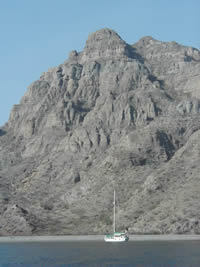 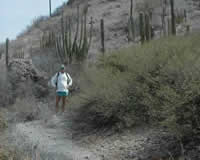 For
the first time in the Sea we had bird life that went beyond the
everyday seagulls, frigates and cormorants. Our favorites were a
pair of black and white osprey who usually perched individually
at the top of a cardón cactus. Their call was surprisingly
sweet for a bird of prey. One morning, one of them entertained us
by spending twenty minutes at the water’s edge taking a very
thorough bath. It repeatedly splashed water over his head and under
his wings, all the while carefully keeping an eye out for intruders!
In the same area on our last morning we saw our very first roadrunner,
darting along the beach, over and under some boulders and then up
the mountainside, his long tail pumping in exclamation every time
he stopped. Even though there was no road in sight – and,
sad to say, no “beep-beeps” -- he was unmistakable! For
the first time in the Sea we had bird life that went beyond the
everyday seagulls, frigates and cormorants. Our favorites were a
pair of black and white osprey who usually perched individually
at the top of a cardón cactus. Their call was surprisingly
sweet for a bird of prey. One morning, one of them entertained us
by spending twenty minutes at the water’s edge taking a very
thorough bath. It repeatedly splashed water over his head and under
his wings, all the while carefully keeping an eye out for intruders!
In the same area on our last morning we saw our very first roadrunner,
darting along the beach, over and under some boulders and then up
the mountainside, his long tail pumping in exclamation every time
he stopped. Even though there was no road in sight – and,
sad to say, no “beep-beeps” -- he was unmistakable!
There is a great
hike across the low saddle behind the sandy beach. Fishermen apparently
use it, as they use both beaches occasi?nally, depending on the
wind direction and tide, to beach their pangas for a rest. The guy
who wrote one of our cruising guides, Gerry Cunningham, must be
quite the hiker, because his charts are 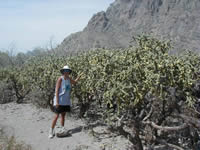 usually
accompanied by photos he has hiked over hill and dale to take! And
just to prove it, he usually has a label on the chart showing his
photo vantagepoint. This entices us, at least, to scramble up hill
and dale ourselves trying to reproduce some of these photos with
Tackless II in the middle. In Caleta Candelero Chico (which earned
the color cover of his Middle Gulf Guidebook), the view should have
been stupendous. But the hills were challenging. Finally I really
understand the concept of “angle of repose”. Although
the hillsides are steep, they don’t seem soooo steep, untilyou
try to clamber up. The way seems clear, because the ground is open
between bits of scrub, but then, about half way along, you feel
as though the soil can’t support any more weight without sliding
out from under you, and there you are teetering! We were pretty
warm when we finally scrambled to the lookout! And there was Tackless
II unphotogenically sitting stern to us and partially obscured by
a knoll. That’s what you get for not anchoring precisely in
the center of the cove! This, too, is another situation where the
digital camera doesn’t cut the mustard. It just doesn’t
have the depth of field and the angle to make such vista shots work.
Sigh. usually
accompanied by photos he has hiked over hill and dale to take! And
just to prove it, he usually has a label on the chart showing his
photo vantagepoint. This entices us, at least, to scramble up hill
and dale ourselves trying to reproduce some of these photos with
Tackless II in the middle. In Caleta Candelero Chico (which earned
the color cover of his Middle Gulf Guidebook), the view should have
been stupendous. But the hills were challenging. Finally I really
understand the concept of “angle of repose”. Although
the hillsides are steep, they don’t seem soooo steep, untilyou
try to clamber up. The way seems clear, because the ground is open
between bits of scrub, but then, about half way along, you feel
as though the soil can’t support any more weight without sliding
out from under you, and there you are teetering! We were pretty
warm when we finally scrambled to the lookout! And there was Tackless
II unphotogenically sitting stern to us and partially obscured by
a knoll. That’s what you get for not anchoring precisely in
the center of the cove! This, too, is another situation where the
digital camera doesn’t cut the mustard. It just doesn’t
have the depth of field and the angle to make such vista shots work.
Sigh.
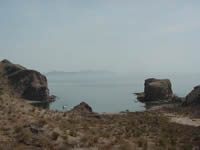 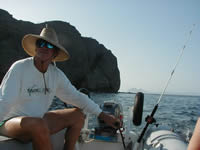 From
this anchorage we also launched our second attempt at trolling for
dinner. Dennis and Lisa of Lady Galadriel and their friend Alan
of The Good Neighbor were up around the corner in the next bay,
so we dinghied up using our two dinghy rods and nice brand new Rapala
lures. Nary a bite did we get. Aboard their boat, however, we got
introduced to chocolate clams on the half shelf, and so resolved
to move around the next morning to learn to “hunt” them.
On the run back to Tackless, however, the lures started to sing.
We caught a grouper, which I lost in my excitement, then we caught
a grunt and a snapper, and, as a finale, two long silvery fish --
one on each rod -- that gave us quite a show, leaping all around,
but which, sadly turned out to be the inedible sport fish called
ladyfish (a demure relative of tarpon.) From
this anchorage we also launched our second attempt at trolling for
dinner. Dennis and Lisa of Lady Galadriel and their friend Alan
of The Good Neighbor were up around the corner in the next bay,
so we dinghied up using our two dinghy rods and nice brand new Rapala
lures. Nary a bite did we get. Aboard their boat, however, we got
introduced to chocolate clams on the half shelf, and so resolved
to move around the next morning to learn to “hunt” them.
On the run back to Tackless, however, the lures started to sing.
We caught a grouper, which I lost in my excitement, then we caught
a grunt and a snapper, and, as a finale, two long silvery fish --
one on each rod -- that gave us quite a show, leaping all around,
but which, sadly turned out to be the inedible sport fish called
ladyfish (a demure relative of tarpon.)
The next morning we moved
Tackless II the short distance around Punta Candelero into the broad
bay where our friends were. This bay becomes very shallow close
by the beach, so the boats have to anchor way out. Ashore were some
palapas with beachgoers frolicking and in the hills a small resort.
Yiee! Civilization! This area is not far south of Puerto Escondido
and Loreto, and the whole stretch of coastline along here is dotted
with the RVs, campers and tents of avid fishing tourists.
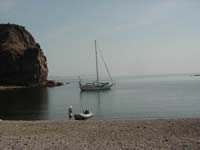 Within
a half-hour of anchor down we were suited up (5mm suits, hood and
gloves) ready for lesson #1 on how to plunder the elusive chocolate
clams. Finding them is the key. These clams bury about four inches
below the sand in at least six to eight feet of water. It’s
amazing how busy a sand bottom is when your begin to study it closely.
There are all kinds of holes and siphons to distract you. The clams
in question, however, give themselves away by projecting up a pair
of siphons very close to one another. Once you pin down the telltale
give away, all the diving, ear-clearing, frantic digging (they are
not always directly below their siphons!) and surfacing gets pretty
rewarding as, in the final analysis, they can’t run from you!
Once you have a stash in your goodie bag, you hang them over the
side of the boat where they will purge themselves of sand overnight
and keep for a couple of weeks or more. Perfect for happy hour hors
d’oeuvres! Within
a half-hour of anchor down we were suited up (5mm suits, hood and
gloves) ready for lesson #1 on how to plunder the elusive chocolate
clams. Finding them is the key. These clams bury about four inches
below the sand in at least six to eight feet of water. It’s
amazing how busy a sand bottom is when your begin to study it closely.
There are all kinds of holes and siphons to distract you. The clams
in question, however, give themselves away by projecting up a pair
of siphons very close to one another. Once you pin down the telltale
give away, all the diving, ear-clearing, frantic digging (they are
not always directly below their siphons!) and surfacing gets pretty
rewarding as, in the final analysis, they can’t run from you!
Once you have a stash in your goodie bag, you hang them over the
side of the boat where they will purge themselves of sand overnight
and keep for a couple of weeks or more. Perfect for happy hour hors
d’oeuvres! 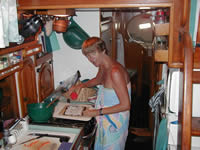
As if that wasn’t
enough excitement, the boys decided to go spearfishing out at the
nearest Candelero, one of several offshore rock spires that give
the whole area its name. As the current was stiff, Lisa and I decided
to stand dinghy watch, ready to collect any of the hunters being
swept away. Of course we tend to assume everyone else is more experienced
at this than “we” are, but no one was more pleased than
Don to discover that he was as successful as the other guys! Especially
as his catch was the much sought-after and more lively yellowtail
– that’s “hamachi” to you sushi bar goers!
With yellowtail on the brain, we all picked up anchor as the afternoon
began to wear down and sailed about seven miles north to Puerto
Escondido.
Puerto Escondido
is a large, completely enclosed anchorage, where, some years back,
Fonatur (the Mexican tourism agency) sank a lot of money into the
infrastructure for a marina here. However, the project stalled well
before completion, and now you have a lovely bay with cement walls,
a huge parking lot and virtually no services except the store and
restaurant belonging to the upscale Tripui Trailer park a mile or
so down the road! (Actually there is a water spigot and trash removal
plus there’s a man who can arrange for fueling by truck.)
Of course, this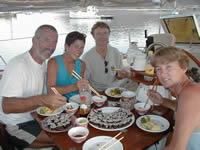 is just the kind of place to attract long-term liveaboards, and
the bay is filled with boats that haven’t moved in months
if not years. Between these “cruisers” and the equally
well-planted trailer park and fishing folk, there is a thriving
gringo alternative community here, and their preparations for the
Fourth of July holiday dictated the time of our arrival.
is just the kind of place to attract long-term liveaboards, and
the bay is filled with boats that haven’t moved in months
if not years. Between these “cruisers” and the equally
well-planted trailer park and fishing folk, there is a thriving
gringo alternative community here, and their preparations for the
Fourth of July holiday dictated the time of our arrival.
In the meantime,
however, the hunters had something less red-white-and-blue in mind
for dinner, and the whole gang convened on Tackless II for the evening
where I turned our yellowtail into a dozen nori rolls while Alan
presented his as sashimi. Oh, the satisfaction of pigging out on
a spread that in a stateside Japanese restaurant would have cost
you a fortune!
|